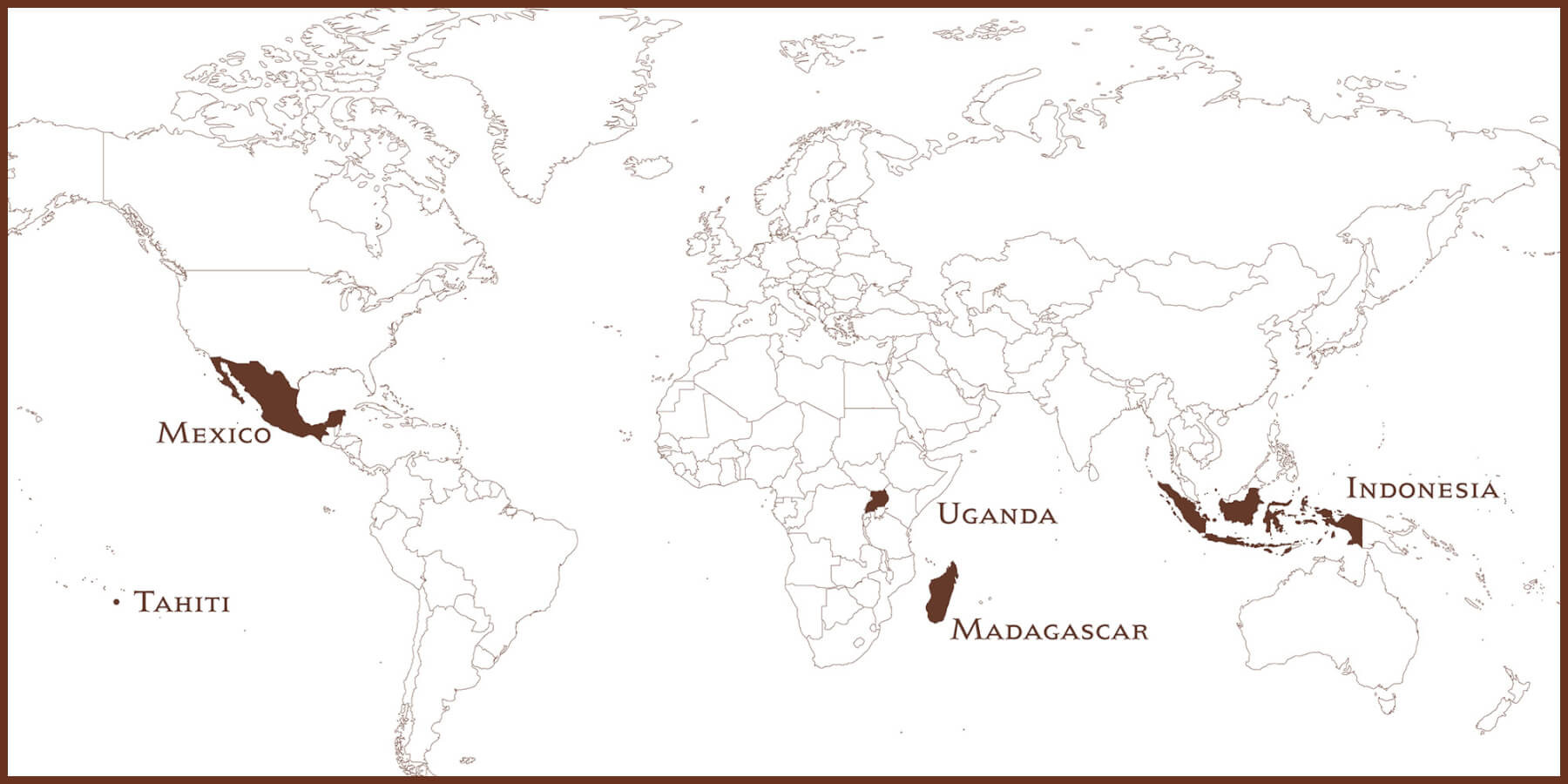Vanilla, a flavor adored worldwide, often sparks curiosity about its origins. While its taste is familiar, the journey of vanilla from its source to our kitchens is a fascinating tale rooted in specific geographical locations. Today, the majority of vanilla beans hail from regions within 10 to 20 degrees of the equator, with Madagascar, Mexico, and Tahiti being prominent sources. Just like fine wines or artisanal chocolates, vanilla exhibits distinct flavor profiles shaped by its terroir, cultivation practices, and curing methods. Madagascar vanilla is celebrated for its creamy sweetness, Mexican vanilla offers a spicy warmth, and Tahitian vanilla is known for its fruity, floral nuances.
 World map showing vanilla growing regions with alt text Vanilla Bean Growing Regions Around the World
World map showing vanilla growing regions with alt text Vanilla Bean Growing Regions Around the World
Despite its global popularity as the world’s most favored flavor, vanilla cultivation is concentrated in a limited number of countries. Let’s embark on a journey to explore five key vanilla-growing regions: Mexico, Madagascar, Tahiti, Indonesia, and Uganda, each contributing uniquely to the world of vanilla.
Mexico: The Ancient Birthplace of Vanilla
Mexico holds the prestigious title of vanilla’s birthplace. The Vanilla planifolia Andrews orchid, the source of most commercial vanilla, is indigenous to Mexico. For centuries, the secrets of vanilla cultivation were guarded by the Totonac people, later falling under Aztec rule. When Hernán Cortés conquered the Aztec empire, vanilla pods made their way to Spain, introducing this exquisite flavor to Europe and beyond. However, for nearly three centuries, Mexico remained the exclusive domain of vanilla production. This exclusivity was due to a unique symbiotic relationship between the vanilla orchid and the Melipona bee, a tiny bee native to Mexico. This bee was the sole natural pollinator of the vanilla orchid flower, a crucial element in vanilla bean production.
Vanilla beans begin as green pods on the vine, reaching harvest ripeness when their tips start to turn a pale yellow. The curing process is paramount, transforming the green beans into the familiar brown, fragrant pods we know. In Mexico, this curing process involves a traditional method of wrapping the harvested beans in blankets and straw mats, followed by a period in ovens for 24 to 48 hours. Subsequently, the beans are laid out under the sun’s warmth during the day to absorb heat and then placed in wooden boxes overnight to encourage sweating. This meticulous cycle of sun exposure and sweating continues until the beans are properly cured. Finally, they are stored on racks and in conditioning boxes for several months, allowing their flavors to fully develop and mellow. The entire curing process in Mexico is a labor-intensive undertaking spanning three to six months.
Tasting Notes: Mexican vanilla is characterized by a rich and harmonious blend of sweet and woody notes, underpinned by a deep, spicy character reminiscent of clove and nutmeg.
Try It Now: Mexican Pure Vanilla Extract
Madagascar: The Hand Pollination Revolution
Madagascar, located off the southeastern coast of Africa, is part of the Bourbon Islands, a region that also includes Réunion, Mauritius, Comoro, and Seychelles. The term “Madagascar Bourbon Vanilla” refers to this geographical origin, not to any association with bourbon liquor.
Around 1793, a vanilla vine was smuggled from Mexico to Réunion Island. For almost half a century, despite successful vine growth and beautiful blossoms, vanilla production remained elusive in this new environment. The absence of the Melipona bee, vanilla’s natural pollinator in Mexico, meant that pollination by local insects was infrequent and unreliable. A breakthrough came in 1836 when Belgian botanist Charles Morren identified the critical role of the Melipona bee in vanilla pollination.
However, it was Edmond Albius, on Réunion Island in 1841, who revolutionized vanilla cultivation. He developed a practical and efficient technique for hand-pollinating vanilla flowers. This innovation, perfected for commercial scale, allowed growers to selectively pollinate the best flowers and optimize spacing on the vine, resulting in healthier and higher-quality vanilla pods. Coupled with Madagascar’s ideal hot, humid climate and fertile soil, hand pollination by skilled and patient farmers propelled Madagascar to become the world’s leading vanilla producer, both in terms of quantity and superior quality.
In Madagascar, the curing process shares similarities with the Mexican method but incorporates a distinct step. Farmers initiate curing by briefly immersing the green vanilla beans in hot water. Following this, the beans are placed in sweat boxes before embarking on the daily routine of sun-drying and overnight sweating, much like in Mexico. This unique curing process, combined with the favorable growing conditions, contributes to Madagascar vanilla’s signature, rich, and complex flavor profile.
Tasting Notes: Madagascar vanilla is renowned for its sweet, creamy, and smooth flavor.
Try It Now: Madagascar Bourbon Pure Vanilla Extract
Tahiti: A Unique Species and Curing Art
Tahiti, a picturesque island in the South Pacific, boasts a tropical climate perfectly suited for vanilla cultivation. In 1848, French Admiral Ferdinand-Alphonse Hamelin introduced Vanilla aromatica plants to Tahiti, followed by French Admiral Louis-Adolphe Bonard who imported Vanilla fragrans plants two years later. Over subsequent decades, these two species were skillfully crossbred, giving rise to the distinctive Tahitian vanilla beans we know today – Vanilla tahitensis.
Tahitian vanilla undergoes a curing process that differs from those in Madagascar and Mexico. Mature beans are initially stacked in a cool environment for five to ten days until they turn completely brown. Uniquely to Tahiti, they are then rinsed in fresh water. For the next month, growers expose the beans to the gentle morning sun for three to four hours daily. In the afternoons, the beans are wrapped in cloth and placed in crates to promote transpiration. This cycle of sun exposure and wrapping encourages water evaporation and bean shrinkage. Throughout this phase, farmers meticulously smooth and flatten each bean pod by hand, using their thumb and index finger. After a month of sun curing, the vanilla beans are left to dry in a shaded, ventilated area for approximately 40 days, further reducing their moisture content.
Tasting Notes: Tahitian vanilla is celebrated for its fruity and floral flavor profile, often exhibiting notes of cherry and almond.
Try It Now: Tahitian Pure Vanilla Extract
Uganda and Indonesia: Emerging Vanilla Regions
Uganda: Uganda, a landlocked East African country characterized by rolling hills and low mountains, entered the vanilla scene relatively recently. It’s believed that British farmers first introduced vanilla to Uganda in the 1940s.
A unique advantage of vanilla cultivation in Uganda is its capacity for two harvests per year, in December and again in June or July, attributed to the country’s distinct weather patterns. While vanilla-pollinating bees exist in Uganda, their populations are too sparse to be effective for commercial production. Consequently, Ugandan vanilla beans are hand-pollinated, similar to Madagascar. Harvest occurs when the bean ends exhibit a slight yellowing and begin to split. The beans then undergo a blanching, sweating, and storing process akin to that of Madagascar.
Tasting Notes: Ugandan vanilla beans are known for their creamy texture, comparable to Madagascar Bourbon vanilla, but with a slightly sweeter profile and subtle hints of chocolate.
Try It Now: Ugandan Pure Vanilla Extract
Indonesia: Indonesia has risen to become the second-largest vanilla producer globally, after Madagascar, with a focus on production volume. Indonesian growers are known for harvesting all beans from a vine simultaneously, a labor-saving technique. Due to variations in cultivation and curing methods compared to other regions, Indonesian vanilla beans present a sharper, woodier flavor profile. This curing approach enhances bean stability, making them suitable for high-heat applications. Indonesian vanilla beans are frequently blended with vanilla from other origins to achieve balanced flavor profiles.
Try It Now: Indonesian Pure Vanilla Extract
Nielsen-Massey: A Global Vanilla Sourcing Philosophy
Nielsen-Massey Vanillas exemplifies a commitment to sourcing the finest vanilla from across the globe. They procure vanilla from primary vanilla-growing countries, including Madagascar, Mexico, Tahiti (and French Polynesian Islands), Papua New Guinea, Indonesia, India, and Uganda. Their dedication to seeking out the highest quality vanilla to create their products is a core principle. Furthermore, Nielsen-Massey prioritizes making a positive impact on the lives of vanilla farmers and their communities. They are actively involved in initiatives to improve the overall sustainability and health of the vanilla industry, with a particular focus on enhancing economic opportunities for the farmers who are the backbone of vanilla production. More details about these efforts can be found in their 2018 Sustainability and Corporate Responsibility Report.
Vanilla’s journey from its origins to our tables is a global tapestry woven with diverse regions, unique cultivation methods, and rich cultural histories. From the ancient birthplace in Mexico to the hand-pollination revolution in Madagascar and the distinct curing traditions of Tahiti, each region imparts its signature character to this beloved spice. Emerging regions like Uganda and high-production areas like Indonesia further contribute to the global vanilla landscape, ensuring a diverse range of flavors and applications. Companies like Nielsen-Massey play a vital role in connecting consumers to this global network, while also championing sustainability and ethical sourcing within the vanilla industry.


